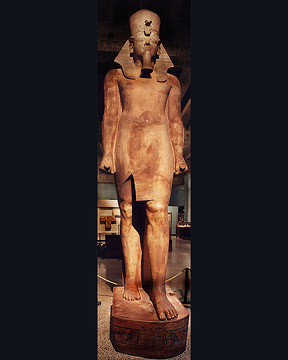Image Resource Bank
Image Gallery |  1 of 15
1 of 15 
Colossal Statue of King Tutankhamun
This heavily restored 18th-Dynasty royal statue was excavated by the Oriental Institute in the ruins of the mortuary temple of Kings Aye and Horemheb on the West Bank in Luxor near Medinet Habu. The restoration is based on a better-preserved statue, which was found with it and kept in Egypt.
The inscription preserved on the statue includes the names of King Horemheb, but the cartouches and many of the epithets on the back pillar have been re-cut, indicating that the statue was originally commissioned for an earlier ruler. Although traces of the original text can be restored as the name of Aye, the predecessor of Horemheb, the youthful features of this statue suggest that it was commissioned by, or on behalf of, King Tutankhamun for his own funerary temple.
This typical royal striding statue was originally accompanied by a small figure of the Queen standing by his left leg and reaching just above the knee. It well exemplifies both the central role of the king and kingship in Egyptian civilization and the artistic convention of using size to indicate relative importance of individuals.
The discovery of King Tut’s tomb in 1924 inspired Egyptomania in Europe, America and the Middle East. Modern Egyptians take great pride in their nation’s pharonic past.
Name: Colossal Statue of King Tutankhamun
Material: Quartzite, pigment
Size:
Height: 5.3 m (17 ft 4 in)
Base:
Length: 1.2 m (4 ft)
Width: 80 cm (2 ft 7 in)
Height: 60 cm (c. 2 ft)
Weight: c. 5.44 metric tons (6 tons)
Date: c. 1334 BCE, New Kingdom, Dynasty 18, reign of Tutankhamun
Place of Origin: Luxor, Egypt, Medinet Habu, Temple of Aye and Horemheb
Location: Oriental Institute Museum, Chicago, Illinois
Source, Registration#, and Publication: Oriental Institute Museum, 14088. Teeter, Emily, Treasures from the Collection of the Oriental Institute, Chicago: The Oriental Institute of the University of Chicago, 2003. pp. 52-54

 Janet H. Johnson
Janet H. Johnson
Morton D. Hull Distinguished Service Professor of Egyptology




